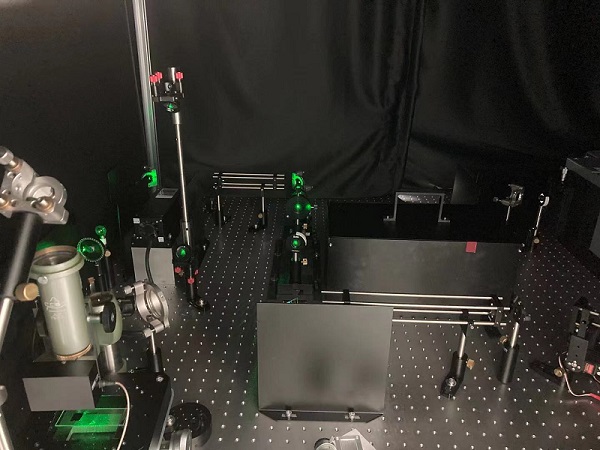HANGZHOU, China, July 2, 2021 — A set of algorithms developed at Westlake University in China enable devices to record and display colors in digital images in a more realistic way. The approach could improve today's commercially available displays and enhance the sense of reality for new technologies such as near-eye displays for VR and AR glasses.
Digital colors on a television or smartphone screen are typically created by combining red, green, and blue (RGB), with each color assigned a value — for example, an RGB value of (255, 0, 0) represents pure red. The RGB value represents a relative mixing ratio of three primary lights produced by an electronic device. Not all devices produce this primary light in the same way, however, which means that identical RGB coordinates can look like different colors on different devices

A portion of the optical setup the researchers built to test their algorithm’s ability to produce colors that adhere to CIE standards. Courtesy of Min Qiu's PAINT research group/Westlake University.
“When we see a beautiful scene, we want to record it and share it with others,” said Min Qiu, leader of the Laboratory of Photonics and Instrumentation for Nano Technology (PAINT) at Westlake University. “But we don’t want to see a digital photo or video with the wrong colors. Our new algorithms can help digital camera and electronic display developers better adapt their devices to our eyes.”
There are other ways, or color spaces, used to define colors, such as hue, saturation, and value (HSV) or cyan, magenta, yellow, and black (CMYK). To make it possible to compare colors in different color spaces, the International Commission on Illumination (CIE) issued standards for defining colors visible to humans based on the optical responses of our eyes. Applying these standards requires scientists and engineers to convert digital, computer-based color spaces such as RGB to CIE-based color spaces when designing and calibrating electronic devices.
The researchers' algorithms directly correlate digital signals with the colors in a standard CIE color space, making color space conversions unnecessary. Colors, as defined by the CIE standards, are created through additive color mixing. This process involves calculating the CIE values for the primary lights driven by digital signals and then mixing those together to create the color. To encode colors based on the CIE standards, the algorithms convert the digital pulsed signals for each primary color into unique coordinates for the CIE color space. To decode the colors, another algorithm extracts the digital signals from an unexpected color in the CIE color space.
“Our new method maps the digital signals directly to a CIE color space,” Wang said. “Because such color space isn’t device dependent, the same values should be perceived as the same color, even if different devices are used. Our algorithms also allow other important properties of color, such as brightness and chromaticity, to be treated independently and precisely.”
The team tested its algorithms with lighting, display, and sensing applications that used LEDs and lasers. Results showed that chromaticity, which is a measure of colorfulness independent of brightness, could be controlled with a deviation of approximately 000.1 for LEDs and 0.001 for lasers. These values are so small that most people would be unable to perceive any differences in color.
The researchers said the method is ready to be applied to LED lights and commercially available displays. Achieving the ultimate goal of reproducing exactly what’s seen by the human eye will require solving additional scientific and technical problems. For example, to record a scene as we see it, color sensors in a digital camera would need to respond to light in the same way as the photoreceptors in our eyes.
The research was published in Optica (www.doi.org/10.1364/OPTICA.422287).